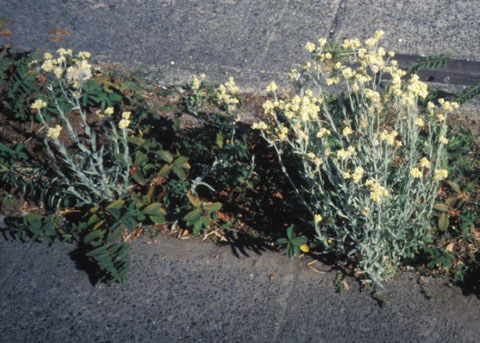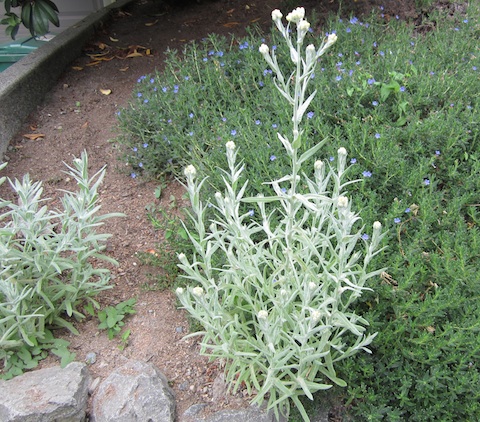
|

|
| Cotton-batting Plant; Gnaphalium stramineum Kunth |
| = Gnaphalium chilense Spreng. |
Sunflower Family; COMPOSITÆ (ASTERACEÆ)
|
| It's pure chance that Velvet Grass immediately preceded Cotton-batting Plant in our monthly series. Both are delightfully soft,
rather minor weeds, of pleasing appearance at least part of the time. |
| This cudweed, also known as Cottony Cudweed, is actually so pretty, and so fascinating to caress, that until it goes to
seed, flops over and takes on a tired look, it is likely to be "spared the spade," so to speak. I routinely wait until flowering begins before
I consign cudweed to its dark and rotten compost fate. |
| It is silvery with shimmering, dense cottony hairs. The leaves are slender and elegantly proportioned. Rarely is the
foliage seen other than in a vibrantly healthy state. When you touch the plant, it feels soft, slightly sticky, and even releases a subtle aroma.
It is a summer annual (or a biennial), and yanks easily from the ground. |
| It blooms from June into November, grows commonly 1 to
21/2 feet tall, and requires sun. The flowers are tiny,
yellowish, and jammed tightly in small button-like heads atop the stems. The plants die after they ripen seeds. |
| This cudweed is far larger and more likable than its dwarf cousin
G. uliginosum (November 1993). It is native from
Chile (as its name chilense implies) all the way north to the Seattle region and beyond. A related native species is
G. purpureum, differing in bearing dark flowers in elongated clusters. |
All told, more than 100 species of Gnaphalium exist. Some are very difficult to tell apart. At least five have been
found growing in Seattle, but only the two most common have been featured in our series. Pronounced with a silent g, the name (?gname) Gnaphalium derives from the Greek Gnaphalion, meaning a lock of wool: in allusion to the dense whitish hairs coating many of
the species. The common name cudweed also alludes to the chewy hairiness of these plants. The hairs defend against the sun's baking rays, and the devouring jaws of herbivores.
|
Originally published as the Seattle Tilth newsletter Weed of the Month in June 1995, along with an illustration from a book.
Back |

